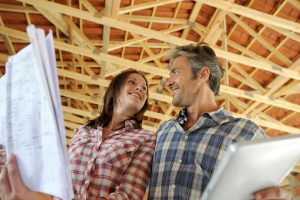The home provides a solid protective layer for its homeowners, with a complex design consisting of walls, foundations, and pillars to ensure that everyone and everything inside remains safe and sound. Those structural features will be part of every home but also serve another purpose. They will also support the most critical feature for home protection: the roof. The roof will be mainly responsible for protecting not just you but your entire home. It will save you from external threats that could result in physical harm. Falling tree branches, destroyed power lines, and extreme weather can result in injuries and fatalities, making the roof an essential protective element of every home.
The roof is durable and reliable, capable of accomplishing what it is built for and protecting people against threats for decades. However, there might come a time when it might need repairs. Years of wear and tear will cause significant damage, which might lead to homeowners requiring more than just repairs or maintenance. However, there might come a point where you might need to consider substantial projects like restoration or replacement. However, you might not know what to pursue since it will be the first time you will perform either of them. Here are a few things you should know when considering roof restoration vs. replacement.
Identify the Maintenance and Repairs First
There will be many things to consider when considering roof restoration vs. replacement. However, addressing any roof flaws before considering significant renovations would be best. Conducting a thorough assessment allows homeowners and property managers to address issues promptly, preventing minor problems from escalating into major, costly repairs. This proactive approach extends the roof’s lifespan and safeguards the property’s interior against water damage, mold growth, and other structural issues. Property owners can implement targeted solutions by identifying specific areas needing attention, optimizing the roof’s performance, and minimizing long-term expenses.
One common concern when assessing a roof’s condition is the presence of a leaky roof. Detecting leaks early on is vital, as water infiltration can lead to a cascade of problems, from compromised insulation to structural decay. In such cases, prompt identification of the leak source enables homeowners to consider roof restoration options rather than a complete replacement. Understanding the nuances between roof restoration vs. replacement is vital, as restoration methods can often address issues effectively, providing a cost-efficient alternative to a complete overhaul. Regular inspections, especially for signs of leaks, empower property owners to make informed decisions, ensuring their roofs endure the elements with resilience.
Seek Professional Guidance

To restore or replace the roof will be your decision, but finding out what you need will require you to seek professional guidance. Ensuring the longevity and structural integrity of your home begins with the expertise of residential roofers when it comes to assessing the condition of your roof. Experienced professionals bring a wealth of knowledge and a keen eye to identify potential issues that may go unnoticed by an untrained observer. Their thorough inspection can unveil hidden vulnerabilities in your residential roof, allowing for early intervention before problems escalate. Entrusting the evaluation of your roof to seasoned professionals ensures a comprehensive understanding of its current state, providing homeowners with the information needed to make informed decisions regarding roof restoration vs. replacement.
When residential roofers conduct an inspection, they focus beyond a mere visual assessment. They employ specialized techniques to gauge the extent of damage, such as infrared technology to detect hidden leaks or weakened areas. This meticulous approach enables them to determine whether a roof requires restoration or an entirely new installation. Factors such as the roof’s age, the severity of existing damage, and the feasibility of repairs are carefully weighed. By weighing these considerations, experienced roofers can provide homeowners with tailored recommendations, guiding them towards the most cost-effective and sustainable solution; roof restoration or a new roof install.
Considering Restoration: What to Do
Homeowners should carefully weigh the benefits of roof restoration vs. replacement when considering the maintenance of their homes. Roof restoration offers a cost-effective and sustainable alternative to complete replacement, often saving homeowners a significant amount of money. It involves repairing and revitalizing the existing roof and addressing leaks, damaged tiles, or worn-out coatings. Restoration over replacement can extend the roof’s lifespan, providing a more environmentally friendly option by minimizing waste.
A roof restoration project typically follows a systematic process to ensure its success. Once the assessment is complete, a detailed plan is developed outlining the necessary restoration procedures. Homeowners can then discuss the proposed plan with the local roofing company, addressing any concerns or preferences they may have. The restoration work includes repairing damaged sections, replacing worn-out materials, and applying protective coatings to enhance durability. Communication between homeowners and the roofing team throughout the project is crucial for a smooth process. Regular updates and attention to quality materials and crafts contribute to a successful roof restoration.
Considering Replacement: What to Do

In certain circumstances, homeowners may find a residential roof replacement more ideal than restoration. Suppose the existing roof has suffered extensive damage, such as severe structural issues or widespread leaks, or has surpassed its expected lifespan. In that case, a complete replacement may be the most effective solution. In cases where multiple layers of repairs have already been performed, the cumulative cost might make roof replacements a more financially sound decision. Additionally, advancements in roofing materials and technology may offer improved energy efficiency and durability, making replacement a strategic investment for the long-term well-being of the home.
Homeowners can expect a carefully planned and executed process when undertaking roof replacements. A detailed replacement plan is developed following a thorough assessment, considering the homeowner’s preferences and any specific requirements. The old roofing materials are removed, and the underlying structure is thoroughly examined and repaired. Finally, high-quality roofing materials are installed, ensuring a durable and resilient roof for years. A residential roof replacement allows homeowners to enhance their home’s overall value and energy efficiency, providing peace of mind and long-term protection against the elements.
Understand the Project
Homeowners play a crucial role in the success of their roofing projects, whether opting for restoration or replacement. Engaging in the process ensures that their needs and preferences are part of it, leading to a more satisfactory outcome. When deciding between roof restoration vs. replacement, local roofing contractors can provide valuable insights into the existing roof’s condition and recommend the most cost-effective and practical solution. Homeowners’ involvement in these discussions allows for a better understanding of the factors influencing the decision, such as the roof’s age, extent of damage, and budget constraints.
To stay immersed in the roofing project, homeowners should actively participate in the initial assessment and planning stages. Collaborating with local roofing contractors, they can discuss materials, styles, and potential enhancements to suit their aesthetic preferences and functional requirements. Regular communication with the contractor throughout the project ensures that any unforeseen issues get promptly addressed. Additionally, being present during inspections and installations allows homeowners to witness the progress firsthand and make informed decisions if any adjustments are needed. By staying involved, homeowners contribute to the project’s success and gain confidence and satisfaction in the longevity and performance of their roofs.
Prepare the Budget

Understanding the financial implications of a roofing project is crucial for homeowners, especially when considering affordable roofing options. The roof restoration cost is generally more budget-friendly than a total replacement, as it involves repairing and enhancing the existing structure. On the other hand, roof replacement can be more expensive due to the labor, materials, and disposal of the old roofing. Homeowners need to weigh these factors and consider the current condition of their roofs when deciding between restoration and replacement. It won’t be easy, but ensuring you have the budget for both will be necessary, and preparations must start early to accomplish the major home improvement project.
To plan for the expenses associated with roofing projects, homeowners should start by obtaining detailed quotes from reputable contractors. This allows them to understand the specific costs and make informed decisions based on their budget. Setting aside a dedicated fund or exploring financing options can help ease the financial burden, ensuring that homeowners can address roofing issues promptly without compromising the integrity of their homes. By prioritizing a well-thought-out budget, homeowners can choose between roof restoration vs. replacement wisely and safeguard their homes against potential long-term damages.
Secure the Materials
Securing suitable materials for your roof is crucial for homeowners looking to save money and ensure the longevity of their investment. By taking charge of the roofing materials, you gain control over the quality and durability of your roof, potentially avoiding frequent repairs and replacements. Choosing a reliable material, such as metal roofing, can be wise due to its longevity and resistance to various weather conditions. Investing in durable materials initially might seem like a higher upfront cost, but it can translate into substantial long-term savings by reducing maintenance and replacement expenses.
Metal stands out for its durability, energy efficiency, and low maintenance requirements when considering roofing materials. A reputable metal roofing service can provide homeowners with a reliable solution that withstands the test of time, offering protection against elements like rain, snow, and extreme temperatures. Additionally, metal roofs often come with extended warranties, providing homeowners with peace of mind and further contributing to the overall cost-effectiveness of the investment. Understanding the benefits and characteristics of metal roofing is essential for homeowners looking to make informed decisions about their property.
While metal roofing offers numerous advantages, there are instances where traditional roof materials may be considered better for certain homeowners. Traditional materials like asphalt shingles or clay tiles may be preferred for their aesthetic appeal, seamlessly blending with the home’s architectural style. Additionally, these materials often come at a lower initial cost than metal roofing, making them an attractive option for budget-conscious homeowners. The familiarity and ease of installation associated with traditional materials can also contribute to their appeal, as they might require less specialized expertise during maintenance and repairs. Ultimately, the choice between traditional and metal roofing depends on your preference.
Think About the Other Features

When taking on a roofing project, it’s crucial to recognize that the decision between roof restoration vs. replacement is not the sole consideration. While these choices significantly impact your roof’s overall health and longevity, overlooking other crucial features can lead to incomplete solutions. A comprehensive approach should extend beyond merely weighing the benefits of roof restoration vs. replacement and encompass a thorough assessment of various elements to ensure the overall effectiveness of the project.
One often underestimated aspect is the significance of gutter installation. Gutters play a pivotal role in directing rainwater away from the roof and the foundation of a building. Properly installed gutters prevent water damage, erosion, and potential leaks. Ignoring the condition or absence of gutters during a roofing project can compromise the long-term integrity of the structure, overshadowing the benefits of a roof restoration or replacement alone. Therefore, including gutter installation in the overall project plan is vital for comprehensive protection against weather-related issues.
You must also consider other essential features when taking on a roofing project. Ventilation systems, for instance, play a crucial role in regulating temperature and moisture levels within the attic space, preventing issues like mold and premature roof aging. Skylights and solar panels may also be considered for those seeking energy-efficient solutions. Each feature contributes to the holistic well-being of your roof and property, emphasizing the importance of a thorough evaluation beyond the binary choice of restoration versus replacement. Addressing these aspects ensures a more resilient and enduring roofing solution for your home or building.
The roof is such a vital part of a home, making it necessary to ensure it remains well-maintained and protected. The decision between roof restoration vs. replacement will cause a lot of confusion for homeowners, but seeking help from professionals will ensure you make the right one. Of course, there is also the choice to perform maintenance and repairs. Still, you must avoid doing them yourself. Roofing professionals can help with your constant roofing needs. Moreover, they can help you decide on roof restoration vs. replacement. When you stay informed, you can ensure your roof will always be the protective feature that every home needs.






